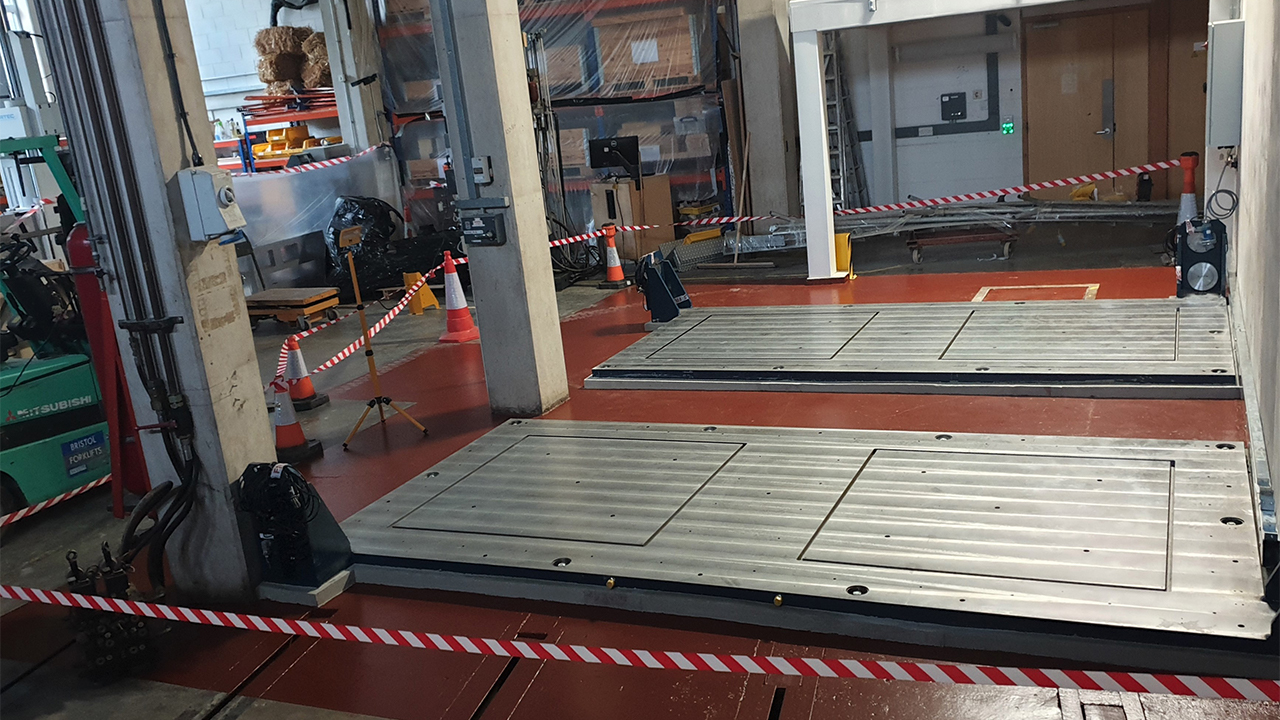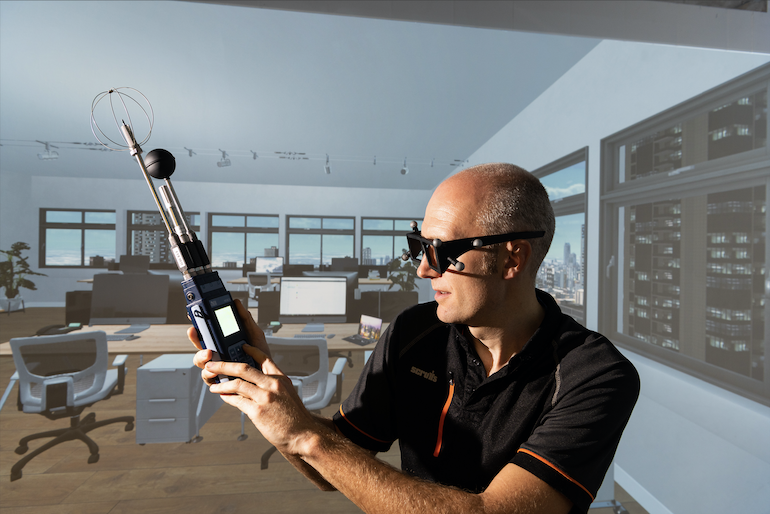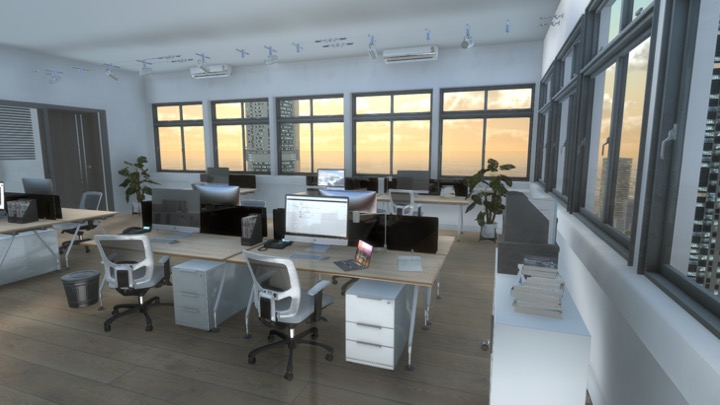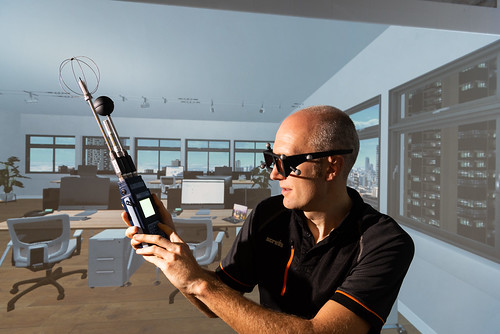Author: Dr Jon Slade -
A moving chamber equipped with virtual reality projection and internal environmental control. That is the VSimulators facility here in our Structures Lab in the Department of Architecture & Civil Engineering. Following a launch event back in October, attended by 100 of the great and the good across academia and industry, the VSimulators facility is now being used for research.
(there is also a sister facility, being built at University of Exeter, which will be used to understand human responses to motion such as that found on bridges and in grandstands)
Our VSimulators facility here in Bath will help researchers study the physiological and psychological effect of environmental factors in a building, including in tall buildings that sway in the wind.
I'm the Experimental Officer for the facility, in charge of operating and maintaining it on behalf of our labs and for Principal Investigator Antony Darby, Head of Civil Engineering (and, working with our Commercial Manager, Julie Lewis-Thompson, we also hire the facility out to industry).
The 3x4m motion platform (on top of which sits a 2m-high chamber) is hydraulically actuated, and able to operate at frequencies between 0.01 and 6Hz and displacements of ±400mm. Its delivery required a special ‘tri-lifter’ forklift (the only one in the country) in order to negotiate the tight space in the lab.


We can also control other environmental parameters in the chamber: temperature (15 to 40°C), humidity (20 to 80%) and lighting illuminance (50 to 2000 lux) and colour temperature (2000 to 6500K). Using hot and cold radiators, warmer or cooler regions can be introduced into the chamber too – inconsistent temperatures across a room are not uncommon in the real world. To achieve all of this we have a climate control system comprising air handling, heating and refrigeration. The chamber includes a sound system, a two-way microphone with the mezzanine control centre and CCTV.
To give a true feel of being in a building, a virtual reality office or residential scene is projected onto the chamber’s walls. The scene includes windows looking out onto a cityscape, animated clouds and even flying birds! The scenes can also be altered to vary the height above ground and time of day.
Construction of the VSimulators facility here in Bath took 6 months, working with three suppliers plus our own Estates department. Due the complexity of the system, overseeing its installation became a full time role for me for those 6 months, and included many long days, late nights and early mornings project managing on my part! (thanks also to my supervisor Neil Price for his support too). Day to day I coordinated suppliers, produced and managed the schedule, and kept Antony, Neil, our other departmental technicians and the wider department up to speed with progress. Thanks to our departmental technicians (who between them have over 130 years of experience in technical roles) for their practical help and support too!




Unlike earthquake simulators, our motion platform operates at much lower frequencies, specifically those corresponding to wind-induced movement. All buildings will move in the wind, to a greater or lesser extent. Sometimes this movement will be below the level of human perception (though the threshold of perception seems to change between individuals). In general, taller buildings move more in the wind. The number of people living and working in cities is increasingly rapidly, and buildings are getting taller. In London alone, more than 500 buildings over 20 storeys (70m) are planned, including 40 buildings over 40 storeys (140m), according to New London Architecture and the Council on Tall Buildings and Urban Habitat.
Yet, while building standards relating to wind-induced motion are focussed on structural considerations (and rightly so!), far less is understood about the effect of that movement on people. What research there is suggests that this motion, perhaps even below the level of human perception, could be having a detrimental effect on productivity and aspects of wellbeing, including through something called Sopite syndrome (an affect not dissimilar to rocking a baby to sleep). But we need to understand more.



This is one of the reasons why the VSimulators facility here in Bath, the only one of its type worldwide, has been built. Working with physiologists and psychologists we want to understand if there is a safe motion ‘dose’. This research, and that focussing on the internal climate, should ultimately mean that we can design buildings which are more comfortable places to live and work.
The VSimulators facilities at Bath and Exeter are not just for research into the human response to the movement of structures – we’ve also received enquiries to use it in the following areas. If you can think of any more then we would be more than happy to talk to you!
- Transport (including the affect of acceleration, deceleration and vibration, and on balance, for drivers and passengers, such as during assisted driving)
- Vibration from machinery (including the effects of vibration on operators and those nearby)
- Creating immersive reality experiences
- Data science and analytics (including the use of multiple information feeds to then develop new ways of visually interpreting, analysing and using complex data)
- Creative industries (including development of new creative techniques, as a tool for expression, performance and storytelling)
For any research enquiries please contact Antony Darby (Principal Investigator & Head of Civil Engineering) absapd@bath.ac.uk or Jon Slade (Experimental Officer) jds89@bath.ac.uk . For commercial enquiries please contact Julie Lewis-Thompson (Commercial Manager) j.a.b.lewis-thompson@exeter.ac.uk. VSimulators is an EPSRC funded research infrastructure project - Grant No EP/P020704/1 & EP/PO20690/1.
Respond
